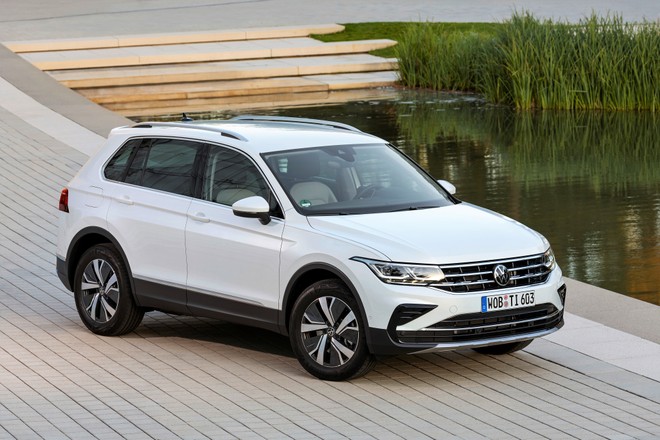
The test of the Volkswagen Tiguan eHybrid : the bestseller of the German company returns to HD in the hybrid plug version -in . As always, we should also have made a video but both technicians who usually collaborate with me were simultaneously (!) Unavailable due to COVID. However, I decided to tell you about the two weeks spent with Volkswagen's successful SUV, in the & ldquo; on tap & rdquo; version.
- DATASHEET Volkswagen Tiguan eHybrid
- TEST Volkswagen Tiguan eHybrid
- ADAS AND SAFETY
- DESIGN AND DIMENSIONS
- HABITABILITY & # 39; AND INTERIORS
- TECHNOLOGY ON BOARD
- VERSIONS AND PRICES
- THE ALTERNATIVES
TECHNICAL DATA VOLKSWAGEN TIGUAN EHYBRID TECHNICAL
- ENGINE: Plug-In Hybrid/4 cylinders – Otto Cycle 1,395 cc Euro 6d-ISC-FCM
- THERMAL ENGINE POWER: 110 kW (150 CV)
- MAXIMUM TORQUE OF THERMAL MOTOR: 250 Nm between 1,550 and 3,500 rpm
- MAXIMUM ELECTRIC MOTOR POWER: 85 kW (115 HP)
- MAXIMUM COMBINED SYSTEM POWER: 180 kW (245 PS)
- MAXIMUM COMBINED SYSTEM TORQUE: 400 Nm
- BATTERY TYPE: lithium ion
- CAPACIT & Agrave; BATTERY: 10.4 kWh
- DRIVE: front
- GEARBOX: 6-speed DSG dual-clutch automatic
- SUSPENSION: Mac Pherson front, Multilink at rear
DIMENSIONS
- LENGTH: 4.511 mm
- WIDTH: 1.859 mm
- HEIGHT: 1.675 mm
- WHEELBASE: 2.681 mm
- BOOT volume min – max: 476 & ndash; 1,516 Liters
- CAPACITY & rsquo; TANK: 45 Liters
- RIMS: in light alloy 7.5 J x 18
- TIRES: 225/40 R18
- WEIGHT: 1,816 kg (in running order)
PERFORMANCE
- SPEED & rsquo; MAXIMUM: 205 km/h
- ACCELERATION: 0-100 Km/h: 7.5 seconds
- CONSUMPTION: 1.6 & ndash; 1.9 l/100 km (combined WLTP)
- ELECTRICITY CONSUMPTION: 145.4 & ndash; 149.2 Wh/km (WLTP)
- CO2 EMISSIONS: 26 & ndash; 28 grams per km (combined WLTP)
- ELECTRIC RANGE: 62-64 km (WLTP)
- STEERING DIAMETER: 11.5 meters
PRICE from 45.100 Euro
TEST VOLKSWAGEN TIGUAN EHYBRID 
The powertrain is not serious; new, we already have it; seen on other PHEV models of the Group: the refined four-cylinder TSI 1.4 turbo petrol direct injection with 150 hp combined with a 115 electric power unit. The transmission is; l & rsquo; 6-speed automatic dual-clutch DSG and traction & egrave; only front (unlike other rivals). The lithium-ion battery has a capacity; of 13 kWh (net of 10.4). The system boasts an overall power of 245 hp (180 kW) and a maximum torque of 400 Nm . In mode 100% electric (they call it E-Mode ) promises an autonomy between 62 and 64 km (in the WLTP cycle) and, where & egrave; possible, they say that & egrave; capable of reaching 130 km per hour.
Unfortunately, its technology does not allow rapid recharging in direct current. The maximum power of charging is; up to 3.7 kW and when a full charge is needed, connecting the Mode 2 cable to a household power socket takes at least about 5 hours . With a public charging station it takes about 3 hours and 40 minutes and, frankly, it is not; little.
In the deadly heat of this summer, in the afternoon, hot weather around 21 & deg ;, I faced the traffic of the city & agrave; and then also a few kilometers in extra-urban. The power of the electric motor is; more that's enough to make the front wheels spin when you hit the throttle firmly. When instead you travel more & ugrave; rest assured, the DSG performs very smooth gear changes. I managed to cover 56 km with zero emissions : I didn't quite reach the promised ones but & egrave; already an interesting result for those who choose a car of this type and use it every day, especially in the city; with similar distances. If it can & ograve; recharge it every day, at home or at work, you can & agrave; travel almost always in mode; with zero emissions.
In the test pi & ugrave; normal, I choose the mode & agrave; Hybrid : the control electronics automatically manage the contribution of the two motors, trying to obtain maximum efficiency, based on the type of path chosen and how much you press on the accelerator.
Choosing the mode instead; Hybrid manual you can set the state of charge you want to maintain on 10 levels: you can then choose whether to increase, reduce or maintain a constant state of charge of the battery during the trip. You can decide for yourself so that you use more & ugrave; l & rsquo; electricity and lower consumption, or save more; possible energy in the battery for later use. The system is interesting because & eacute; it allows you to save energy that maybe you could need more; later, during the journey, in an inhabited center.
As always, it uses braking and deceleration to recover energy and in Hybrid the electric part helps the petrol TSI, turning it off when & egrave; possible or by helping him with a greater thrust, depending on the circumstances.
The change also includes the mode & agrave; B , which helps you to put energy back into the battery through regenerative braking, even as soon as you take your foot off the accelerator.
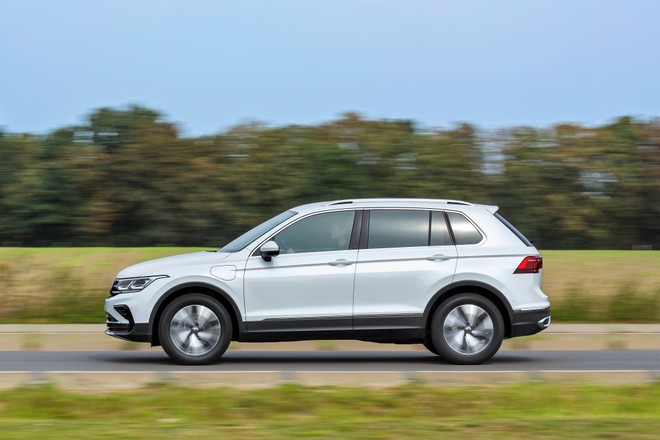
The proven 1.4 TSI turbo it was already; revealed in the past a good powertrain and also on this plug-in hybrid it does not disappoint: & egrave; always ready to provide the necessary boost.
The temperament of the hybrid Tiguan can & ograve; change a lot according to the mode guide you choose. Among the few options present on our test model c & rsquo; & egrave; the DCC , the adaptive attitude adjustment with Driving Profile Selection . The latter intervenes on the response of the engine, gearbox and power steering, while the DCC improves the dynamic behavior of the car and adapts to your mood and driving style.
In mode & agrave; GTE , the most & ugrave; sporty, the electric motor and the petrol TSI work together to offer the best performance: fuel consumption is decidedly in the background and the Tiguan & ldquo; on tap & rdquo; can & ograve; accelerate from 0-100 in 7.5 seconds and reach 205 km/h speed maximum; especially can & ograve; count on a good recovery, after each major slowdown, thanks to the immediate thrust of the electric. But, mind you, it does not claim to be a sports car.
The steering , usually rather light but precise, becomes much more & ugrave; ready. Even if the DCC does what it can, the dynamic behavior (which on the Tiguan & ldquo; normal & rdquo; & egrave; good) always has to deal with the extra weight; also due to the battery, placed in the car floor in front of the rear axle to improve weight distribution: here we are at 1,816 kg , in running order, which are 270 more; compared to the 1.5 TSI and nearly 200 compared to the 2.0 TDI 150 hp, and they feel. I have purposely traveled twice a road that for a few kilometers is; a continuous alternation of curves and l & rsquo; I drove with a little & rsquo; more di brio: & egrave; true that it is not; a car designed to drive sportily but & egrave; is not serious; just the of him, the extra weight; feels and c & rsquo; & egrave; more roll compared to the & ldquo; normal & rdquo; sisters.
For & ograve; he forgives himself by offering good comfort : adaptive suspension and 18 & rdquo; with high-shoulder tires make you travel comfortably, even on the roughest roads; ruined. Obviously with those from 19 & rdquo; of the R-Line version or the very nice 20-inch ones available as an option, it becomes a bit & rsquo; more rigid but never exceeding.
In general, the Tiguan has among its strong points the capacity; to offer great comfort: & egrave; silent, you can hardly hear the engine, there are no noises and vibrations, few even the aerodynamic rustles and you can hardly hear the rolling noise of the tires.
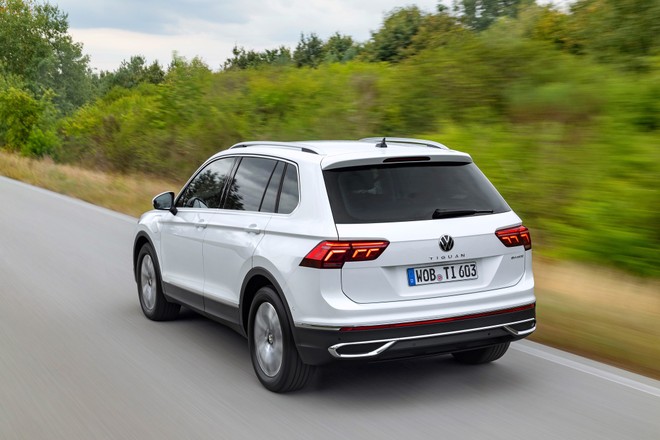
The dual clutch automatic transmission & egrave; a little & rsquo; slow in the modalities normal driving: you will notice, for example, when he has to climb in order to overtake. And & rsquo; definitely in contrast with the readiness of the electric motor but in line with its approach centered on efficiency . Speaking of which, its pi & ugrave; recent technology allows the Tiguan, once a route has been set with the navigator, to use the map data and speed limits; to optimize the use of the powertrain and understand where to make the most of its electric motor.
Positive note also for the brakes : they have never suffered a crisis. They are doing well & hellip ;.
And let's go to the most & ugrave; wait, consumption : the manufacturer declares an average value in the combined cycle between 1.6 and 1.9 liters per 100 km. In real life, in the city with the help of the electric you can do up to 24 km with a liter, and overall, even traveling outside the city, you can do it; approach averages of about 22 km per liter. L & rsquo; highway is not & egrave; the best place for the plug-in Tiguan: at 130 per hour it is 13 per liter; when the battery runs out and c & rsquo; & egrave; even the extra weight, it takes even more; of 8 liters per 100 km. At that point, even in the city; and outside you do not go beyond 14 per liter.
If you load it every day and, of course, you are not grinders of km and rarely frequent the motorway, then it can be; make sense. Otherwise it is better to opt for a different engine.
ADAS AND SECURITY 
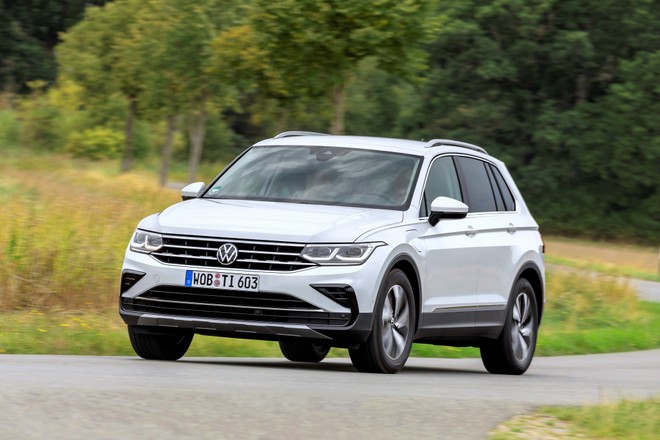
The Tiguan & egrave; sure, there is no doubt. Already in the entry version, the Life, as standard there are: adaptive cruise control, Front Assist with emergency braking and pedestrian recognition, lane change assistant and parking exit and more. In the intermediate one, the Elegance like ours, are added: adaptive cruise control with predictive function, Park Assist with rear view camera, dynamic recognition of signs and, since safety also includes what we see and what others see, there are also the LED matrix headlights with dynamic adjustment which, depending on the conditions, distribute the light by activating or deactivating individual segments of LEDs.
With 335 Euros more; for the basic version or 135 for our intermediate version, you have the complete package with the now famous Travel Assist : combines the function of adaptive cruise control with the adaptive lane keeping system. As the most enthusiasts now know, it is activated with a single button on the steering wheel and works at speed; between 0 and 210 per hour: cos & igrave; the Tiguan accelerates, brakes and holds the lane by itself. The German SUV's ADAS allow for level two autonomous driving and I would say that they are all well calibrated. Adaptive cruise control is not; never abrupt in his movements and with the lane assistant he is also able to follow the curves well. Definitely positive.
DESIGN AND DIMENSIONS 
I don't dwell too much on the design of the Tiguan, because & eacute; by now you know him quite well, & egrave; always her: minimal and discreet, with a line that does not dare but that is hardly dissatisfied. With the restyling yes & egrave; evolved and aligned with the already stylistic course; undertaken by the brand with other models. The renewed design of the front , with the new light signature with LED technology headlights in the new main headlights, helps us to distinguish it from the previous version. Now all versions come with LED headlights as standard.
The dimensions : length 4.511 mm, width 1.859 mm, height 1.675 mm and pitch 2.681 mm.
HABITABILITY AND INTERIORS 

Speaking of technology, already in the test with the 1.5 TSI ACT 150 hp we were able to appreciate the improvement obtained with the adoption of the infotainment platform MIB 3 , plus; powerful and fast: yes & egrave; expanded the range of functions, which includes the online services of We Connect and We Connect Plus.
On our eHybrid & egrave; the Ready2Discover radio as standardwith 8 & Prime; touch display, gesture control and ready for navigation (which can also be activated after purchasing the paid car directly from the shop integrated into the system via We Upgrade), streaming and internet are also available for a fee. In the package c & rsquo; & egrave; also the App-Connect with wireless function to integrate Apple CarPlay and Android Auto . Standard since the entry version c & rsquo; & egrave; the Digital Cockpit Pro with 10.25 & Prime; display. Navigation & egrave; good, rather intelligent and & egrave; also visible in the digital dashboard display, which allows you to choose which information to display.
The home charging solution & egrave; the wallbox , which in the access version ID. Charger costs 499 Euros; the most expensive ID. Charger Connect (designed for families with multiple drivers) and Pro (for company car drivers) add Wi-Fi, Ethernet or LTE telephone connection and allow you to manage recharging even remotely with the dedicated app.
VERSIONS AND PRICES 
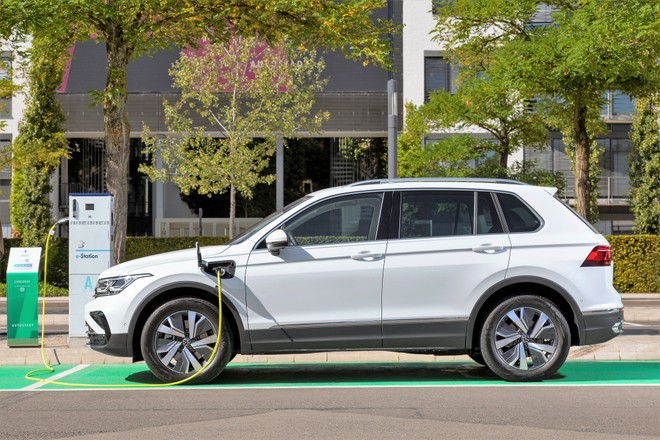
The eHuan Volkswagen eHuan price list Model Year 2023 starts from 45.100 Euro of the Life version, up to 50,300 of the Elegance version and 51,000 of the R-Line. Between the latter two there is no & rsquo; & egrave; a big difference in price: your choice simply depends on whether you want it with a better look; sober and elegant or more & ugrave; sporty.
The Life as standard it offers 17-inch alloy wheels, LED headlights with Light Assist, front and rear parking sensors, tinted rear windows, 3-zone automatic climate control, front seat lumbar adjustment, 10.25 & Prime; Digital Cockpit Pro, Ready2Discover infotainment with 8-inch touch screen and App-Connect with wireless function, adaptive cruise control and all the ADAS that I already have there; listed.
The Elegance of our test adds 18-inch alloy wheels, Matrix IQ.LIGHT LED headlights with Dynamic Light Assist and IQ.LIGHT LED rear lights with dynamic indicators, chrome hand rails, Park Assist with rear view camera, Discover Media navigator with 8 & Prime display; , adaptive cruise control with predictive function, dynamic signage recognition and more.
The R-Line stands out for its 19 & Prime; with 255/45 R19 tires, windows with chromed profile, exterior and interior R-Line package, leather sports steering wheel, Top Comfort front seats and other details that make it more comfortable; gritty.
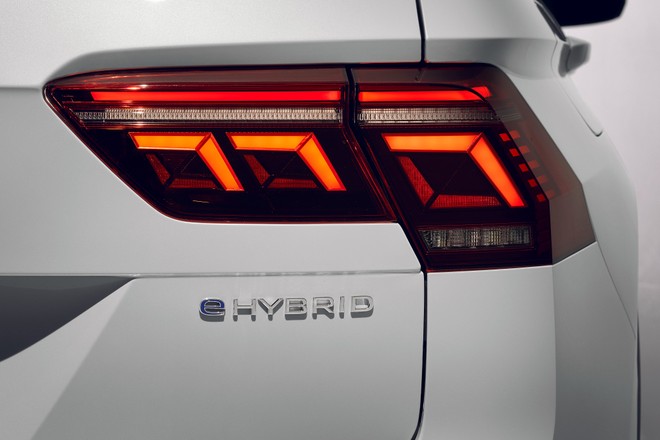
Taking a look at the prices the plug-in hybrid, on an equal footing; of preparation, it costs about 600 Euro more & ugrave; compared to the version with the 200 hp turbodiesel (which for & ograve; has four-wheel drive) and 3000 more; compared to the petrol one with the 190 hp TSI, which for & ograve; they should recover with incentives. But the advice is; always the same: the car must be chosen based on the use you make of it. If you grind many kilometers for work and many on the motorway, the diesel version is; still the right one, but if you travel between 30 and 60 km a day every day and you can recharge it every day, this engine could be the ideal one.
The qualities of the Tiguan we already know them: & egrave; well built, refined and pleasant to drive; with the restyling it was already; revealed more technological and more; safe. Unfortunately, like almost all competitors, it has a smaller luggage compartment capacity and a dynamic behavior that is not entirely satisfactory. However, it remains one of the most popular among the PHEV SUVs. interesting.
VOLKSWAGEN TIGUAN ONLINE CONFIGURATOR
THE ALTERNATIVES
In its segment the Tiguan has among its rivals: Seat Tarraco , powered by the same powertrain, Ford Kuga (tested by Luigi), Toyota RAV4 , DS 7 Crossback E-Tense , Kia Sorento and cousin Hyundai Santa Fe . Which would you choose?

 Auto 19 Jan
Auto 19 Jan

 Toyota RAV4 Plug-in Hybrid, sales start in Italy: fittings and prices 20
Toyota RAV4 Plug-in Hybrid, sales start in Italy: fittings and prices 20
Auto 01 Dec

 DS 7 Crossback: new hybrid version Plug-in 9
DS 7 Crossback: new hybrid version Plug-in 9
Auto Jun 15

Kia Sorento Plug-in Hybrid arrives in Italy: up to 57 km in electric 17
Auto 03 Mar

 Hyundai Santa Fe, the Plug-in Hybrid arrives in Italy: up to 58 km in electric 5
Hyundai Santa Fe, the Plug-in Hybrid arrives in Italy: up to 58 km in electric 5
Auto 10 Aug
The TOP of the range pi? small? Samsung Galaxy S21, buy it at the best price from eBay at 552 euros .

